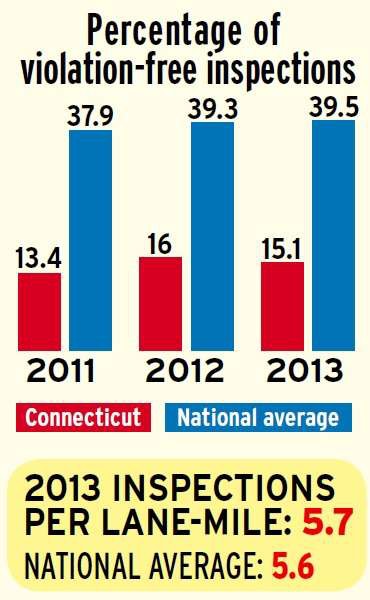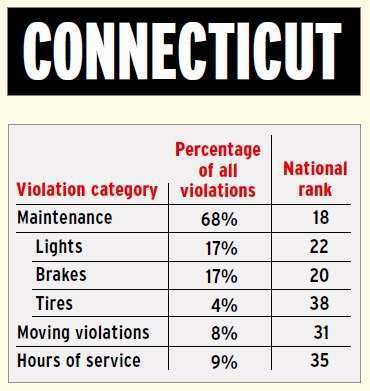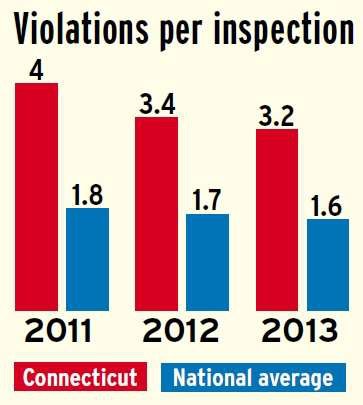
Independent owner-operator Joe Bielucki is familiar with what it’s like to encounter an officer with the Connecticut Department of Motor Vehicles’ Commercial Vehicle Safety Division, the lead agency performing the state’s truck inspections. Bielucki happens to be based there, having carved out a niche doing relatively short open-deck hauls where few truckers from elsewhere in the nation want to go.
Though Bielucki’s last Level 1 inspection in Connecticut was nearly four years ago, what the inspecting officer told him rings true with the state’s trends in recent years. In terms of the individual inspection, Connecticut leads the nation in two metrics in Overdrive’s analysis: total violations per inspection (high) and percentage of clean inspections (low). The latter is important because clean inspections help driver and fleet scores under the Compliance, Safety, Accountability program.
“The young inspector told me that he always will find something,” says Bielucki, and that’s exactly what he did: missing reflectors on the back of the cab and under the trailer’s taillights.
 For this and the next four months, we’ll profile states that stand out for their enforcement intensity, violation propensity or other reasons. For more detail by state, you can access interactive maps charting a raft of enforcement data via Overdrive’s CSA’s Data Trail site: OverdriveOnline.com/csa.
For this and the next four months, we’ll profile states that stand out for their enforcement intensity, violation propensity or other reasons. For more detail by state, you can access interactive maps charting a raft of enforcement data via Overdrive’s CSA’s Data Trail site: OverdriveOnline.com/csa.Bielucki tries to avoid the Connecticut DMV when possible – not easy given that a typical day of hauling might take him out of the state and into Massachusetts, Rhode Island and back home. His 30 years of experience tell him the department “seems to have an anti-trucker bias” as a general rule, though he does give kudos to the Connecticut State Police’s truck squad for the professionalism of a trooper who handled an accident he was involved in years ago.

Lt. Donald Bridge, lead Motor Carrier Safety Assistance Program (MCSAP) coordinator for the division, says the overall program is made up of about 150 certified inspectors; about 60 are DMV, with state police making up the difference, in addition to about 10 to 12 from a variety of local jurisdictions.
National rankings: Violations per inspection
Bridge is aware of the state’s reputation for being tough on truckers who are put under the microscope of the state inspection program. “We hear that a lot from the drivers,” he says, casting it a different way: “We’re thorough.”
In 2013, a scant 15 percent of Connecticut’s inspections resulted in the driver coming away with a clean report, far below the national average of 39.5 percent. Measuring violations per inspections, Connecticut also leads the nation at 3.2, just above second-place finisher Wisconsin at 3.1.
Bridge dismisses charges of nitpicking enforcement and gives kudos to officers department-wide for focusing on what he calls the “bad operators” – those who tend to show their colors by “following too close, speeding, doing things that they shouldn’t be doing.”
National rankings: Least percentage of clean inspections
Vehicles that obviously are in questionable condition are more apt to be selected for Level 1 inspection by weigh-station personnel, Bridge says. Officers are trained to not waste time on brand-new trucks: “There’s nothing accomplished by that.”
A big part of the department’s hiring process is to assess the candidate’s mechanical expertise, and Bridge points to himself, a former trucker, as an example; he’s also been a mechanic and a safety manager. “A lot of my personnel are licensed mechanics, and all have some sort of mechanical experience, which helps a lot even when picking out the trucks that should be checked,” he says.


The good news? If Bielucki’s right about those troopers, you’re most likely to catch a Connecticut inspection away from the weigh station, and that’s relatively unlikely unless you’re committing a moving violation. In 2013, inspections at one of Connecticut’s six scales accounted for only 33 percent of its inspections. As in other states covered in Overdrive in recent months (Maryland, Pennsylvania, Indiana), mobile roadside enforcement has been on the rise in Connecticut, from 64 percent of all inspections in 2011 to slightly above 67 percent in 2013.
Another bit of good news is that Connecticut’s nation-leading violations-per-inspection rate is falling relatively quickly, down 20 percent since 2011; by comparison, the national rate in that time period is down 11 percent.

While the CSA program and the bright light it’s shone on maintenance issues may be partly responsible, Bridge believes the effectiveness of its enforcement unit’s targeted efforts shares in the improvements, extending to CMV crash-dense areas around New Haven and Hartford.
|
Connecticut singled out in ATRI geographic disparity report on CSA That report was followed by two letters to the U.S. Department of Transportation from a a broad swath of industry trade groups calling for SMS BASIC scores to be removed from public view. ATRI’s report also offered a methodology that might normalize scores in the BASICs according to geographic area of operation. |
Looking at the 2007-08 timeframe, the I-91/I-95 intersection and general vicinity in New Haven showed almost 200 crashes a year, says Bridge. His department increased inspections, created a visible police presence and go after moving violations. Today, the area shows “well under 50 crashes per year.”
Hartford and vicinity, says Bridge, is now the No. 1 crash area, but after years of reductions, the truck-enforcement division’s efforts now seem to be showing little added result – similar to New Haven. “We’re seeing the number stagnate,” Bridge says, and they’re moving to a judgment on the problems as resulting from “more a roadway-design issue than a driver-behavior issue.”
But don’t look for enforcement to lighten up in either region. New Haven is “in the process of a roadway design and change.” Bridge says. “As long as we stay focused on our enforcement there” – provided they see a reduction in crashes following the improvement – “we can equate that to the roadway.”











